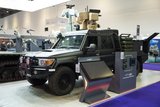G/ATOR Block II completes CDR
Northrop Grumman and the US Marine Corps (USMC) have completed the preliminary design review (PDR) and critical design review (CDR) of the Ground Weapon Locating Radar (GWLR) mode for the AN/TPS-80 Ground/Air Task-Oriented Radar (G/ATOR), the company announced on 23 August.
The PDR was carried out on February and CDR in August, completing all design reviews and making way for an initial integration event (IIE) in October. Under the IIE, initial testing of the system will be carried out and data on several targets will be taken to assist in the remaining integration work.
The IIE will be an initial demonstration of G/ATOR’s ability to track and detect multiple types of mortar, artillery and rocket rounds simultaneously. G/ATOR Block II offers longer-range threat detection and tracking than current US counter-fire target acquisition radars.
The GWLR mode adds software to the G/ATOR system for detecting, tracking and identifying rocket, mortar and artillery projectiles, both sector-only and 360-degree. This mode addresses various types of simultaneous threats.
Roshan Roeder, director, mission solutions, Northrop Grumman, indicated that the company expects to achieve initial operating capability for G/ATOR Block II in mid-2018.
Related Equipment in Defence Insight
More from Digital Battlespace
-
![Babcock nears first customer for Nomad AI translation tool]()
Babcock nears first customer for Nomad AI translation tool
Nomad can provide militaries with real-time intelligence, saving critical time on the battlefield.
-
![AUSA 2025: Israel’s Asio Technologies to supply hundreds of improved Taurus tactical systems]()
AUSA 2025: Israel’s Asio Technologies to supply hundreds of improved Taurus tactical systems
Taurus operates alongside the Israel Defense Forces’ Orion system which supports mission management across tens of thousands of manoeuvring forces, from squad leaders to battalion commanders.
-
![AUSA 2025: Kopin pushes micro-LED plans as China moves faster]()
AUSA 2025: Kopin pushes micro-LED plans as China moves faster
The plan for the new displays follows fresh investment in Kopin’s European facilities by Theon and an order for head-up displays in fielded aircraft, with funding from the US Department of Defense.
-
![AUSA 2025: Persistent Systems to complete its largest order by year’s end]()
AUSA 2025: Persistent Systems to complete its largest order by year’s end
Persistent Systems received its largest ever single order for its MPU5 devices and other systems earlier this month and has already delivered the 50 units to the US Army’s 4th Infantry Division.
-
![Aselsan brings in dozens of companies and systems under the Steel Dome umbrella]()
Aselsan brings in dozens of companies and systems under the Steel Dome umbrella
Turkey has joined the family of countries attempting to establish a multilayered air defence system with government approval in August 2024 for the effort landed by Aselsan. Dubbed Steel Dome, the programme joins Israel’s Iron Dome, the US Golden Dome, India’s Mission Sudarshan Chakra and South Korea’s low-altitude missile defence system.
-
![DSEI 2025: MARSS unveils new agnostic multidomain C4 system]()
DSEI 2025: MARSS unveils new agnostic multidomain C4 system
MARSS’ NiDAR system has been deployed using sensors from static platforms to provide detection and protection for static sights, such as critical infrastructure, ports and military bases.




























